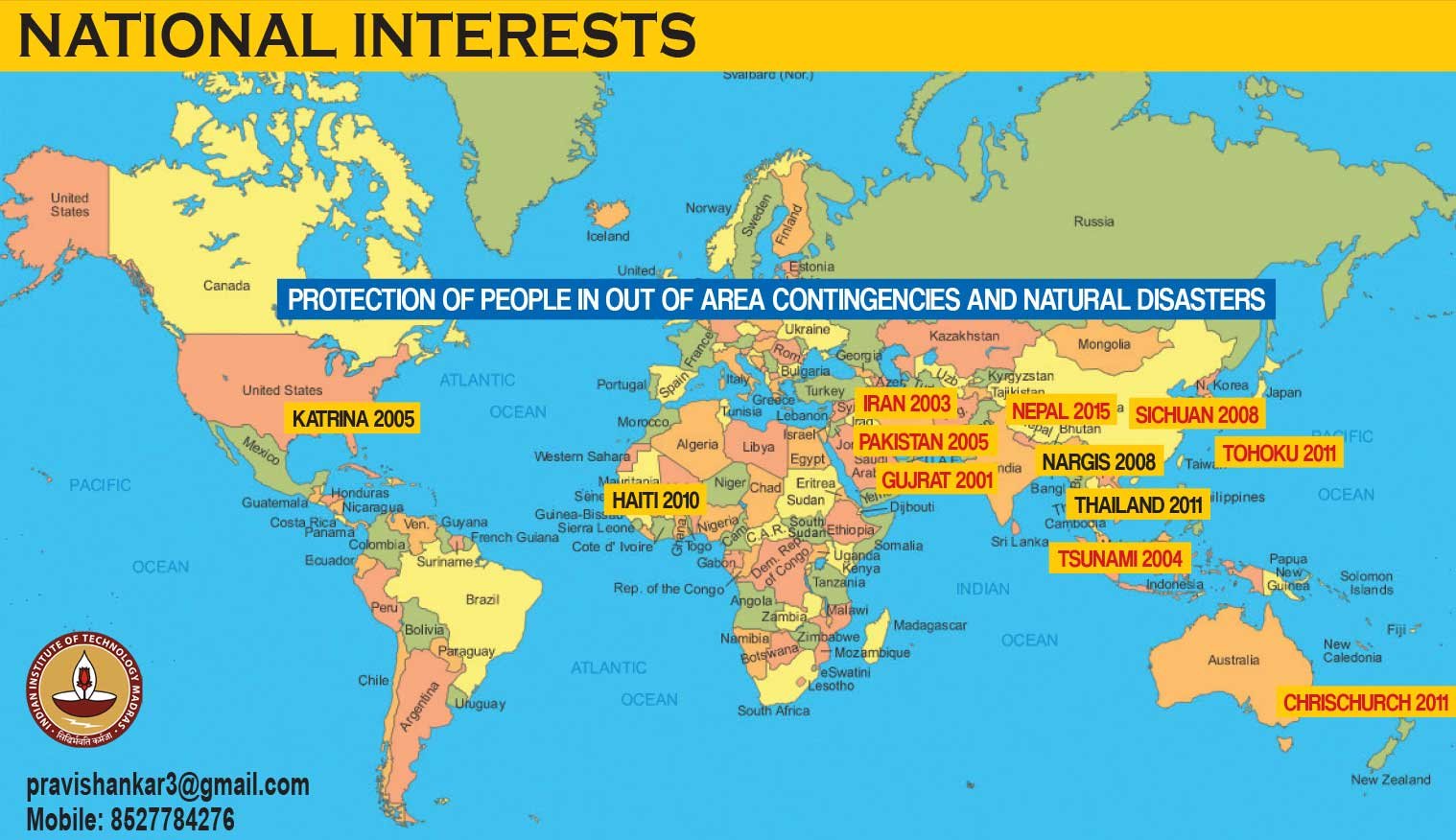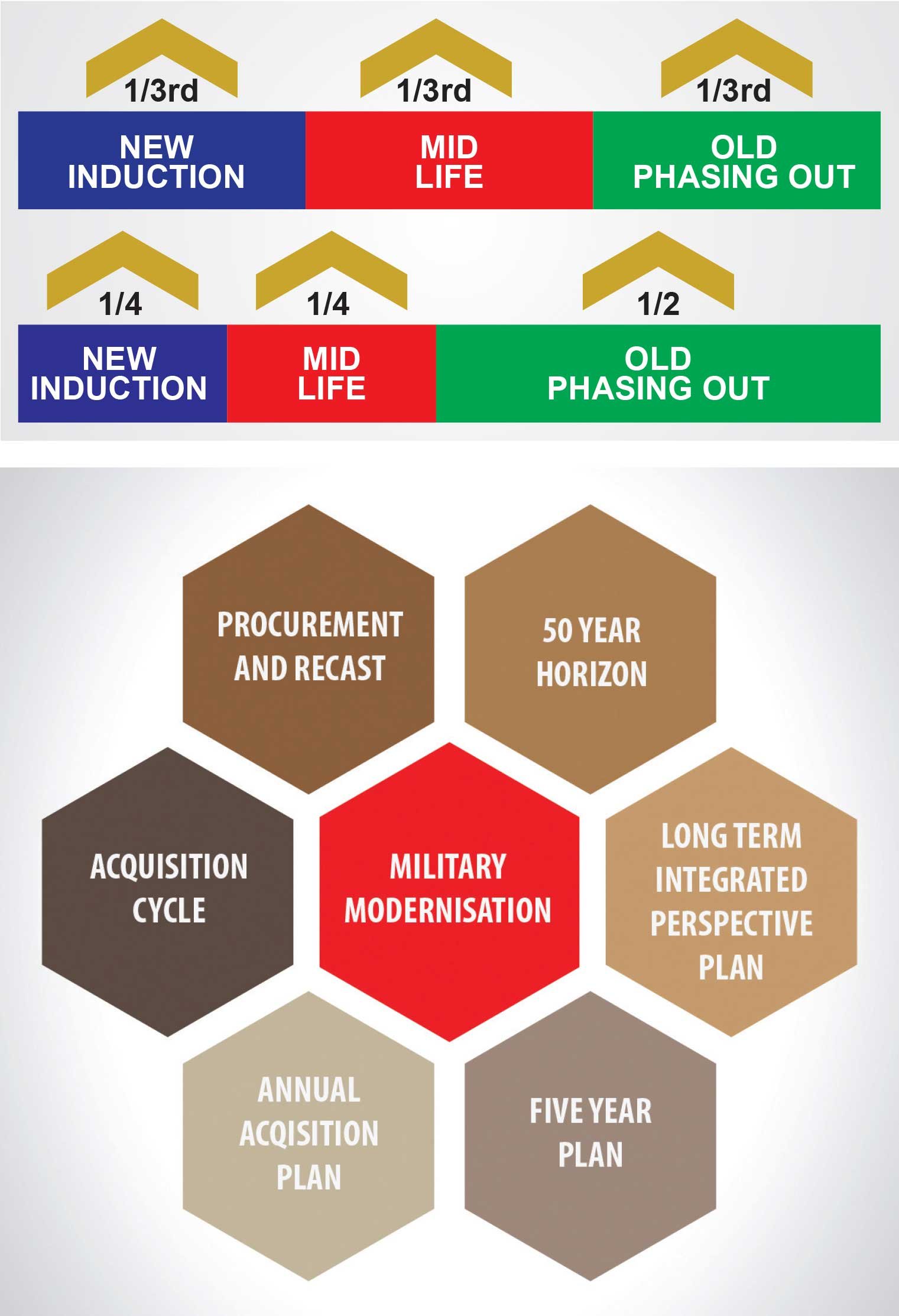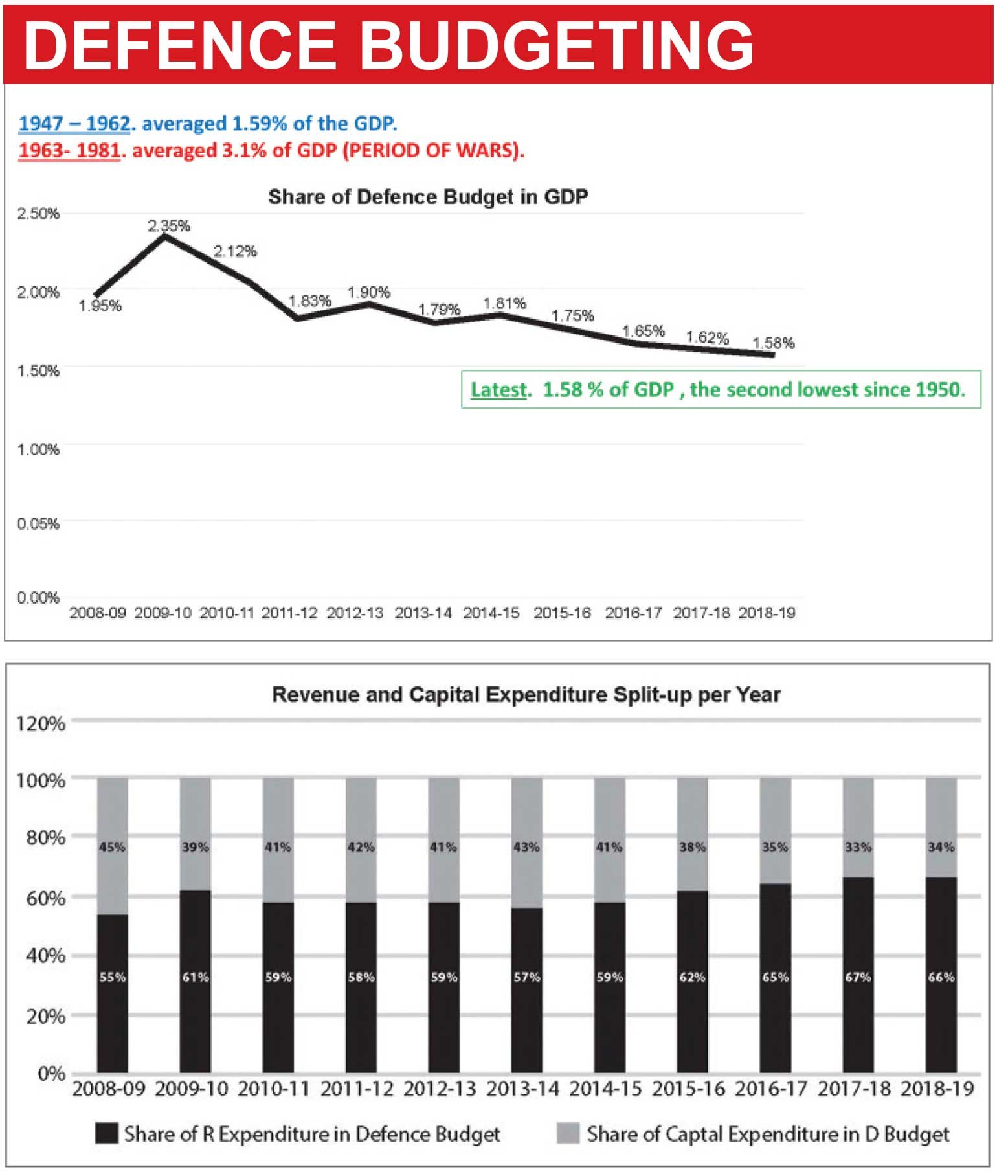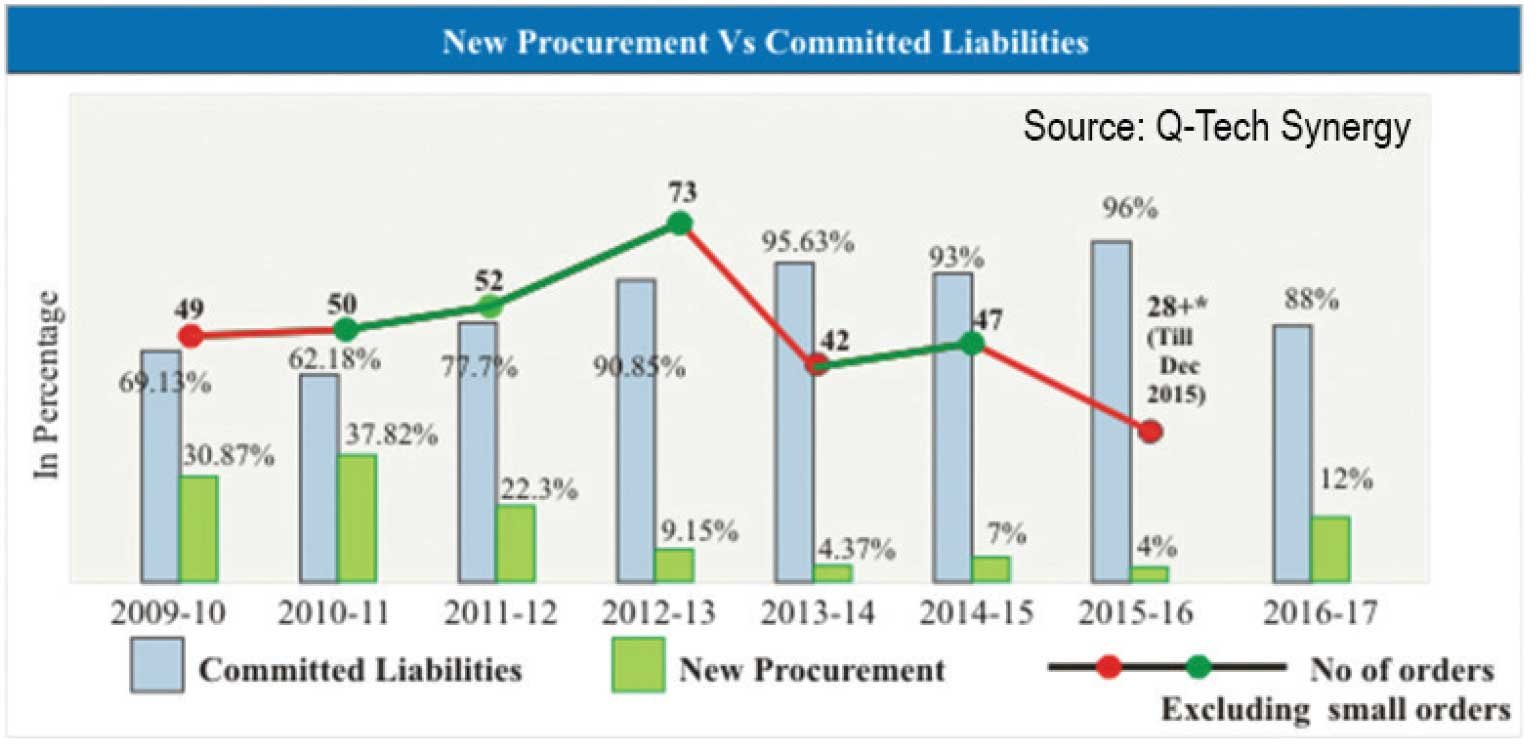INDIA’s national interests are essentially enshrined in our constitution. Those which the Indian Armed Forces safeguard are: 1) Protection of land borders, coastline, island territories and sea lanes from external aggression from land, sea and air. 2) Internal protection of people and constitution against terrorism, extremism, insurgency and militancy. 3) Protection of Indians in the areas of contingencies, such as evacuation from troubled areas/ conflict zones like it happened in Kuwait and Yemen, and during natural disasters.
In order to protect our national interests, a detailed threat assessment is done. Accordingly, the Indian Armed Forces are structured to thwart these threats. However, with constantly changing geopolitical alignments, technology development and economic growth; the threats and the means to counter them also change over time. It is therefore our constant endeavour to be ahead of the curve through modernisation.
Basic Issues of modernisation
Force modernisation is a complex subject and is never complete. In the real world there are two basic questions which need to be considered.
- Are the Indian Armed Forces modern enough to defend India? The answer is yes. This was clearly visible in Doklam where China baulked at conflict escalation.
- Are the Indian Armed Forces modern enough for a regional power which is destined to be the third largest economy? The answer is no, not yet.
 At present, India’s force structure is designed to combat the threat it faces. As India grows to be a regional power, we must gravitate to be a force like the USA wherein we have the capability to combat any threat. Alternately, we could be part of a collective capability partnership/ alliance like the NATO/EURO. That is what the proposed QUAD grouping with the USA, Japan, Australia and India is all about.
At present, India’s force structure is designed to combat the threat it faces. As India grows to be a regional power, we must gravitate to be a force like the USA wherein we have the capability to combat any threat. Alternately, we could be part of a collective capability partnership/ alliance like the NATO/EURO. That is what the proposed QUAD grouping with the USA, Japan, Australia and India is all about.
The military teeth of a nation are represented by its Air Force, Navy, Infantry, Mechanised Forces and Artillery. When these are examined, it emerges that due to the Rafale muddle, delay in Tejas and regular crashes of ageing aircraft, the IAF is in a tight spot of depleting numbers. While the Indian Navy transited from a ‘buyer’s’ navy to a ‘builder’s’ navy, we lag for onboard systems like weapons, surveillance systems and communication systems. Our Infantry lacks a basic rifle. Efforts to redress the issue are just taking shape. Our Mechanised forces lack ammunition and engines. Our Artillery modernisation is just taking off. Overall, we are far from the ideal situation.
Modernisation process
Ideally, at any given point of time, 1/3rd of our equipment should be new (under induction), 1/3rd in midlife and balance 1/3rd should be phasing out. In our case, it is just about 25 per cent in the new induction stage and the balance being old.
We have lagged in modernisation due to many factors. Modernisation of the armed forces is based on perspective planning. Perspective planning for a nation has a minimum 50-year horizon encompassing threat assessment, technology vision and its socio-economic trajectory. From this vision is drawn a 15-year working document called the Long-Term Integrated Perspective Plan (LTIPP). This is further broken into 5-year plans by each Service and then converted into an Annual Acquisition Plan which is an action plan to execute specific programmes. At present, our LTIPP is just a compilation of individual plans of Army, Navy and Air Force.
 In the absence of an informed political hierarchy, a joint defence structure headed by a Chief of Defence Staff, a knowledgeable bureaucracy and a strong R&D / production base we lack a cogent integrated national perspective. This is the major problem of our modernisation. The second problem of modernisation is that the industrial revolution bypassed us, but we are still striving for technologies of that era, when disruptive technologies are making their impact. Disruption in Military Affairs will change the forms of conflict in the future. A new form of conventional warfare is evolving. We must modernise for these requirements.
In the absence of an informed political hierarchy, a joint defence structure headed by a Chief of Defence Staff, a knowledgeable bureaucracy and a strong R&D / production base we lack a cogent integrated national perspective. This is the major problem of our modernisation. The second problem of modernisation is that the industrial revolution bypassed us, but we are still striving for technologies of that era, when disruptive technologies are making their impact. Disruption in Military Affairs will change the forms of conflict in the future. A new form of conventional warfare is evolving. We must modernise for these requirements.
Budget
We can only be as modern as we can afford. In India, there is always a tussle between bread and bullets and the bread invariably wins. However, beyond a point people must tighten their belts to protect themselves. It is an international norm that one must spend at least 2 per cent of the national GDP to have strong defence forces. However, we have spent only an average of 1.6 – 1.8 per cent for the past several years.
Within this, the Armed Forces have gone through an expansion as well. In the net assessment, our armed forces have expanded on a shrinking budget, made to do on a budget meant for smaller force and inflation has not been catered for. That is a negative triple whammy. As a result, there are holes in the Force Capabilities which have got bigger. For a comparison, the USA spends 4-5 per cent of its GDP on defence. Pakistan and China spend about 3 per cent of their GDP on defence.
 Every budget has two parts in it – Revenue (pay, allowances of personnel and upkeep of existing equipment) & Capital (new equipment). Capital allocation has been continually shrinking due to force expansion and increase in pay and allowances. Capital itself has two parts, new schemes and committed liability of previous purchases. What is left for modernisation in the strictest sense is a small pie. This small pie gets shared between the three Services and is grossly inadequate. In real terms, Modernisation budget and allocations have been shrinking. It also implies that we must carry out diligent prioritisation.
Every budget has two parts in it – Revenue (pay, allowances of personnel and upkeep of existing equipment) & Capital (new equipment). Capital allocation has been continually shrinking due to force expansion and increase in pay and allowances. Capital itself has two parts, new schemes and committed liability of previous purchases. What is left for modernisation in the strictest sense is a small pie. This small pie gets shared between the three Services and is grossly inadequate. In real terms, Modernisation budget and allocations have been shrinking. It also implies that we must carry out diligent prioritisation.
Procurement issues
After having a modernisation budget, we need to understand how we go about procuring equipment for the armed forces. There are some basics of procurement. These are as follows: –
- Defence acquisition is not a standard open market commercial form of procurement. One cannot buy rifles like brinjals.
- High standards of public trust in the people who procure defence equipment is a prerequisite. In addition, transparency, probity and public accountability are very important. Most importantly, commitment to cause, knowledge and team work are required in these issues. As a nation, we have fallen short as evidenced by scams which have dotted our defence procurement horizon – Bofors, HDW, Kargil Coffin scam, Tehelka, TATRA, Augusta Westland and the ongoing Rafale controversy.
- There is a need to have a balance between competing requirements of
- Expeditious procurement
- High quality standards
- Appropriate costsDefence procurement has some unique features. These are as under: –
- There are supplier constraints since not everybody has the capacity to make weapons.
- Technological complexity of weapon systems makes it difficult to assess, evaluate and procure.
- Foreign suppliers have problems in many respects.
- High costs are not justifiable in many cases.
- Foreign exchange variations impact on cost and budgeting.
- Geo-political ramification of a deal could be complex.
 After this, there are some fundamental choices to make. First, whether to design or develop indigenously, go in for a foreign procurement or buy from Indian sources. The next choice is whether going in for a normal or fast-track procurement. That is based on our operational requirements. The third choice is to go in for new equipment or upgrade an old weapon. This is important considering that one cannot replace about 50 per cent equipment in one go. It is not affordable or absorbable. The factors to consider are that buying new equipment means more effectiveness, latest technology, costly but low on maintenance. However, infrastructure change, training and transition instability are involved. Upgradation is less effective, cheaper since costs are postponed and high on maintenance. However, infrastructure and training costs are low. Transition instability is low and most importantly it leaves us with an option to go for the next generation in the later timeframe. Finally, the decision is situational, and it depends on what you need, what you afford and what you can wait for.
After this, there are some fundamental choices to make. First, whether to design or develop indigenously, go in for a foreign procurement or buy from Indian sources. The next choice is whether going in for a normal or fast-track procurement. That is based on our operational requirements. The third choice is to go in for new equipment or upgrade an old weapon. This is important considering that one cannot replace about 50 per cent equipment in one go. It is not affordable or absorbable. The factors to consider are that buying new equipment means more effectiveness, latest technology, costly but low on maintenance. However, infrastructure change, training and transition instability are involved. Upgradation is less effective, cheaper since costs are postponed and high on maintenance. However, infrastructure and training costs are low. Transition instability is low and most importantly it leaves us with an option to go for the next generation in the later timeframe. Finally, the decision is situational, and it depends on what you need, what you afford and what you can wait for.
Once this decision process is done, the procurement process starts. The procurement process is a maze similar to the snake and ladder game whose steps are given in DPP 2016.
- Issuing a Request for information (RFI).
- Defining services qualitative requirements (SQRS).
- Get the acceptance of necessity (AON) from the defence acquisition council.
- Tendering and solicitation of offers (RFP).
- Technical evaluation of equipment.
- Field evaluation.
- Staff evaluation.
- Technical oversight.
- Commercial negotiations / contract negotiation.
- Approval of competent financial authority (CFA).
- Contract/supply order placement (SO).
- Contract execution and post-contract management.
- This process could take up to 2-3 years or more depending upon the complexity of the weapon system being procured. Add the planning time, production time, and delivery time. One sees that any procurement of a modern weapon system becomes a decadal process. In the meantime, goal posts could change through disruptive technologies, changing threat perceptions and geopolitics. The entire process is very risky and iffy.
 This process is similar in most countries. Notwithstanding all this, modernisation happens in the western world at a good pace and in aggressively ambitious countries like China. In our case, we have some major challenges. These are outlined below: –
This process is similar in most countries. Notwithstanding all this, modernisation happens in the western world at a good pace and in aggressively ambitious countries like China. In our case, we have some major challenges. These are outlined below: – - It is the duty of our political and bureaucratic hierarchy to put the best weapon in the soldier’s hands. They have failed to a large extent since a national perspective is lacking and our processes are deviled by scams. They must get their act together.
- Indigenous design, development and production represented by 51 DRDO labs and establishments, 41 ordnance factories and 9 DPSUS have not met our growing aspirations. It is dotted by poor quality, unacceptable delay, poor technology and research capability. We have invested heavily in them and we should make them work. Reform through knowledge infusion and effective leadership is the order of the day.
- Private defence industry is at a nascent stage and will take at least a decade or more to even come up to scratch. In the meantime, we must get the best of our youth to contribute to this country and not make the Apples, Googles, Microsofts and Pepsis of another world rich and prosperous.
- The Services must master the knowledge of making this machinery move. Indian Navy and Artillery have done that. Others should follow their model. Also, there is a need to reassess the total force levels with which we are to function. We cannot expand and modernise. If we modernise, we should contract and if we expand, we cannot modernise. India cannot afford both.
- We need to have an integrated joint approach which is feasible only if there is a CDS. For all this to happen, there is a need of a major relook at the staffing pattern at MOD and the kind of bureaucracy who will be at the helm of defence modernisation.
- The country needs to allocate greater budgets for defence to build modern defence capacities if we are to be able to meet the threats emanating from a toxic Pakistan and a predatory China.Having said this, you might wonder if anything can go right in this regard. My answer is, yes, it can. Our ability to defend our country has been exemplified by the indigenous strides we have made in the field of space technology, nuclear technology, missile technology, ship building, gun technology, aircraft technology and communication technology. However, we need to shift our focus on becoming a sea power, fill in the major gaps and attune ourselves to the oncoming storm of disruption in military affairs. Luckily, China has some instability – cooling economy, BRI pushback and a military in transition. Our toxic adversary Pakistan is economically defunct. This gives us a ten-year window of opportunity to set our house in order. In this ten-year window we must carry out surgical strikes on the defence procurement machinery to make it work. These are highlighted in the box.
– The author is a retired Director General of Artillery, Indian Army and Professor of Aerospace Department, IIT Madras









